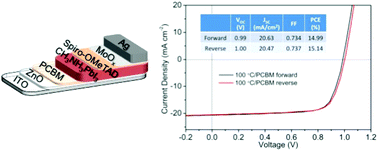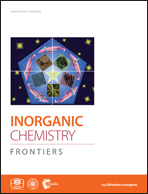Environmentally friendly, aqueous processed ZnO as an efficient electron transport layer for low temperature processed metal–halide perovskite photovoltaics†
Abstract
Here we report the incorporation of ZnO electron transport layers (ETLs), deposited using a remarkably simple water-based processing route, for use in methylammonium lead iodide (MAPI, CH3NH3PbI3) perovskite solar cells. The influence of ZnO processing temperature on the thermal stability and surface morphology of the perovskite films is studied in detail. We find that operational devices are achieved over the entire ZnO processing temperatures range investigated (100–450 °C) – however those prepared at 100 °C are significantly affected by current–voltage hysteresis. We find that the insertion of a thin phenyl-C61-butyric acid methyl ester (PCBM) layer between the ZnO and the MAPI significantly reduces current–voltage (J–V) hysteresis. Additionally we determine that the thermal stability of the MAPI improves when PCBM is inserted as an interface modifier. The fabrication of the PCBM modified ZnO at 100 °C enables the formation of low-temperature processed, thermally stable normal architecture cells with negligible hysteresis.

- This article is part of the themed collections: Inorganic Chemistry Frontiers HOT articles for 2018 and Inorganic Chemistry Frontiers HOT articles for 2017


 Please wait while we load your content...
Please wait while we load your content...